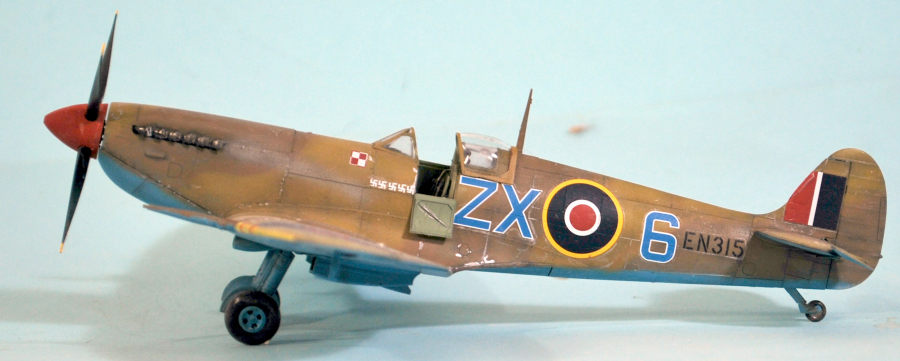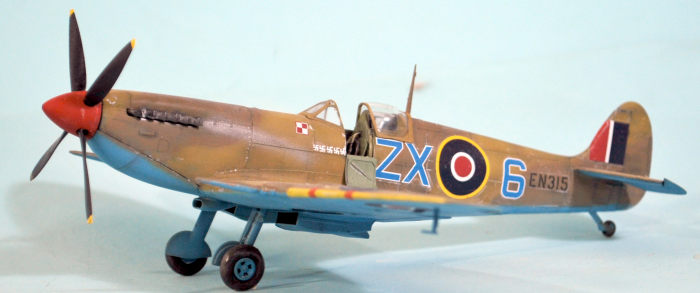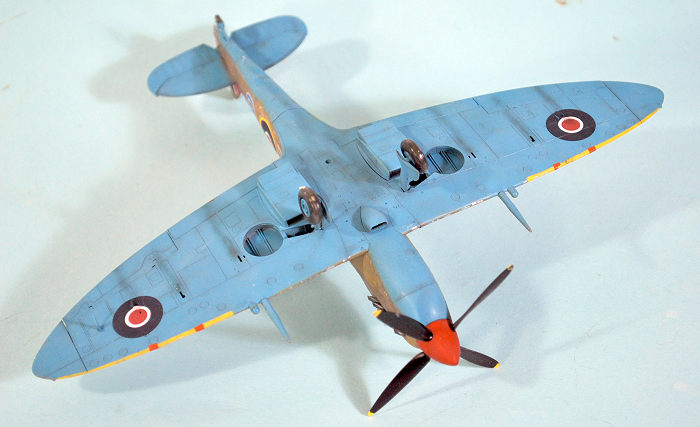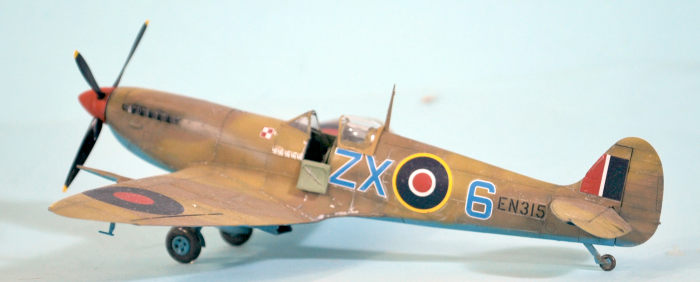
Eduard 1/48 Spitfire IX
| KIT #: | 84137 |
| PRICE: | $29.95 |
| DECALS: | One option |
| REVIEWER: | Tom Cleaver |
| NOTES: | Weekend Edition |

| HISTORY |
Had not the RAF been able to bring a new Spitfire into combat in the summer of 1942 to face the Fw-190A that could outfly the Spitfire V on every point but turning circle, the war over Northern Europe would have likely taken a different course. As it was, the RAF had to stop daylight operations over northern France twice - in November -December 1941 and in March-April 1942 - due to high losses of Spitfires operating against JG 2 and JG 26 on the Channel Front. The new Merlin 61-powered Spitfire VII and VIII with their 2-stage superchargers could match the Fw-190's performance, but were at least a year away from production.
As a
“stopgap,” two Spitfire Vc airframes, AB196 and AB197, were given strengthened
longerons Merlin 61s with 2-stage superchargers were mounted. AB196 first flew
on February 26, with AB197 taking to the air a month later. Both were successful
and on the strength of these results the Spitfire IX was ordered
 into production
at Castle Bromwich immediately. Even given top priority, the Spitfire IX did not
fully equip all RAF fighter squadrons in the UK until late 1943. The "interim"
Mk.IX became the second most-produced Spitfire, running close behind the
Spitfire V, and gave the RAF parity with the best German equipment. As leading
Spitfire IX ace Johnny Johnson noted in his autobiography, "Wing Leader," the
Spitfire IX and the Fw-190A were so closely-similar in performance that the
outcome of a fight was a matter of pilot ability.
into production
at Castle Bromwich immediately. Even given top priority, the Spitfire IX did not
fully equip all RAF fighter squadrons in the UK until late 1943. The "interim"
Mk.IX became the second most-produced Spitfire, running close behind the
Spitfire V, and gave the RAF parity with the best German equipment. As leading
Spitfire IX ace Johnny Johnson noted in his autobiography, "Wing Leader," the
Spitfire IX and the Fw-190A were so closely-similar in performance that the
outcome of a fight was a matter of pilot ability.
Stanislaw Skalski and the Polish Fighting Team
The Polish Fighting Team (PFT - Polski Zespół Myśliwski), also known as "Skalski's Circus"(Cyrk Skalskiego), was a Polish unit which fought alongside the British Commonwealth Desert Air Force in the North African Campaign during 1943.
In late 1942, the Polish Air Force Staff Command requested permission from the RAF to send a group of pilots to North Africa to acquire experience in operating as a part of a tactical air force in preparation for future Allied landings on the European continent.
Volunteers had to have completed at least 30 missions; 70 volunteers were considered before 15 pilots were chosen. The group was formed at Northolt on February 5, 1943 as the Polish Fighting Team, initial preparations for overseas service took place at RAF West Kirby, and the unit embarked on February 24, arriving in Tunisia on March 13, 1943. They could not have arrived at a better time, since II/JG 2 was wreaking havoc with Allied fighters as the demonstrated the Fw-190's continued superiority.
The team was initially attached as 'C' flight, to No. 145 Squadron RAF led by Squadron Leader Lance Wade, an American in the RAF. The squadron was equipped with the Spitfire Vb, operating from Bou Grara Airfield, 150 miles west of Tripoli.
 Commencing
operations on March 18, the unit gained an immediate reputation for combat
effectiveness. They were so soccessful that they re-equipped with rare Spitfire
Ixs that had been sent in haste to counter JG 2's Butcher Birds in late March.
Commencing
operations on March 18, the unit gained an immediate reputation for combat
effectiveness. They were so soccessful that they re-equipped with rare Spitfire
Ixs that had been sent in haste to counter JG 2's Butcher Birds in late March.
Flying officer Mieczysław Wyszkowski was the only casualty in the PFT, shot down and taken prisoner-of-war on 18 April. Following the surrender of the German Army in Africa on 13 May, the PFT was disbanded. During its two months on operations, the Polish pilots had claimed a total of 26 German and Italian aircraft shot down. Skalski scored four, and Pilot Officer Eugeniusz Horbaczewski claimed five victories.
Three pilots stayed on and became part of Desert Air Force units; Skalski became Commanding officer of 601 Squadron, Horbaczewski CO of 43 and Drecki a Flight Commander in 152. Skalski was the first Pole to command an RAF squadron. He took part in the invasion of Sicily and invasion of Italy. From December 1943 to April 1944 Wing Commander Skalski commanded No. 131 Polish Fighter Wing.
| THE KIT |
Eduard’s Spitfire IX kits were the first of their Spitfire series, with the first release in 2013. The kits rapidly established themselves as the best Spitfires available in 1/48. This weekend edition lacks the photoetch of the Profipack kits and has only one markings option on the decal sheet, an airplane from the USAAF 31st Fighter Group in North Africa. I opted to use the sheet from the first Profipack release, to do the airplane flown by Stanislaw Skalski in the Polish Fighting Team.
| CONSTRUCTION |
As with any Eduard kit, you must clean of all the parts completely. No sprue nubs, no paint on mating surfaces. Clean! This is because the Computer CAD design of the kit is very precise, and any ill-fit at any stage will cascade into multiplying fit problems further into the process.
 When assembling
the cockpit, it is important to get the seat assembly in correctly: the frame
the seat is attached to must be fully vertical - this is easy to slip up on, and
will lead to bad fit. Other than that, the only other “fiddly moment” with the
fuselage is the exhaust stacks. I cannot understand how Eduard came up with the
design they did, but the only alternative to buckling down and doing the
assembly is to get expensive resin replacements. It’s too bad the upper cowling
cover isn’t one piece, but with careful assembly, you will only have a glue
ridge to scrape down, and there is no surface detail in the immediate vicinity
of the joint; if you were careful in assembly, you won’t need to do any
sanding-down, which loses detail. Or you can opt for the resin correction piece
that Barracuda Studios has created.
When assembling
the cockpit, it is important to get the seat assembly in correctly: the frame
the seat is attached to must be fully vertical - this is easy to slip up on, and
will lead to bad fit. Other than that, the only other “fiddly moment” with the
fuselage is the exhaust stacks. I cannot understand how Eduard came up with the
design they did, but the only alternative to buckling down and doing the
assembly is to get expensive resin replacements. It’s too bad the upper cowling
cover isn’t one piece, but with careful assembly, you will only have a glue
ridge to scrape down, and there is no surface detail in the immediate vicinity
of the joint; if you were careful in assembly, you won’t need to do any
sanding-down, which loses detail. Or you can opt for the resin correction piece
that Barracuda Studios has created.
If you assemble the wing completely before attaching that sub-assembly to the fuselage, you will have to engage in “industrial-strength pushing and shoving” to get it in position, and there is a high likelihood you won’t get a completely-smooth connection on the upper surfaces. I have discovered an easier way to do this, that guarantees a good fit:
Assemble the gear wells in the lower wing part, then attach the lower wing to the fuselage. Then attach the upper wing parts, starting with the wing-fuselage joint, which you can now get good and tight and perfect with just careful alignment. Then glue the upper parts to the lower part.
Past these items, assembly of everything else is easy. Just commit to the revolutionary act of following the instructions and you are well on the way to a great model for your collection.
| COLORS & MARKINGS |
 I first
painted the yellow leading edge on the outer wings and then masked that off. I
then preshaded the model with flat black on the panel lines. I painted the lower
surfaces Azure Blue from my Tamiya mixture. The upper surface was painted in an
“Aboukir” pattern that approximates the A scheme, using my Tamiya mixtures for
Dark Earth and Middle Stone.
I first
painted the yellow leading edge on the outer wings and then masked that off. I
then preshaded the model with flat black on the panel lines. I painted the lower
surfaces Azure Blue from my Tamiya mixture. The upper surface was painted in an
“Aboukir” pattern that approximates the A scheme, using my Tamiya mixtures for
Dark Earth and Middle Stone.
I used the decals from the first Profipack release, along with the stencil decals provided in the kit.
These airplanes were only in use for about five weeks before the unit had their final operation. They would have been sun-faded and dirty, but likely not heavily dinged. I did exhaust stains with light grey for the leaned fuel mixture used, and oil stains on the bottom, and a minimum of “dings.” I then attached the landing gear and prop, gave the model an overall coat of clear flat, attached the canopy in the open position and called it done.
| CONCLUSIONS |
The kit is still as nice as it was nine years ago. Eduard kits have a reputation for “fiddliness” that is deserved, but if you follow instructions, take your time and persevere, you’ll be assured of an excellent result. If you want easy, get Tamiya’s Spitfire IX - oh, that’s right, they don’t make one in 1/48.
Recommended for intermediate modelers. There will always be room for one more Eduard Spitfire here at Le Chateau du Chat.
17 February 2022
Copyright ModelingMadness.com. All rights reserved. No reproduction in part or in whole without express permission.
Review kit courtesy of my wallet.
If you would like your product reviewed fairly and fairly quickly, please contact the editor or see other details in the Note to Contributors.